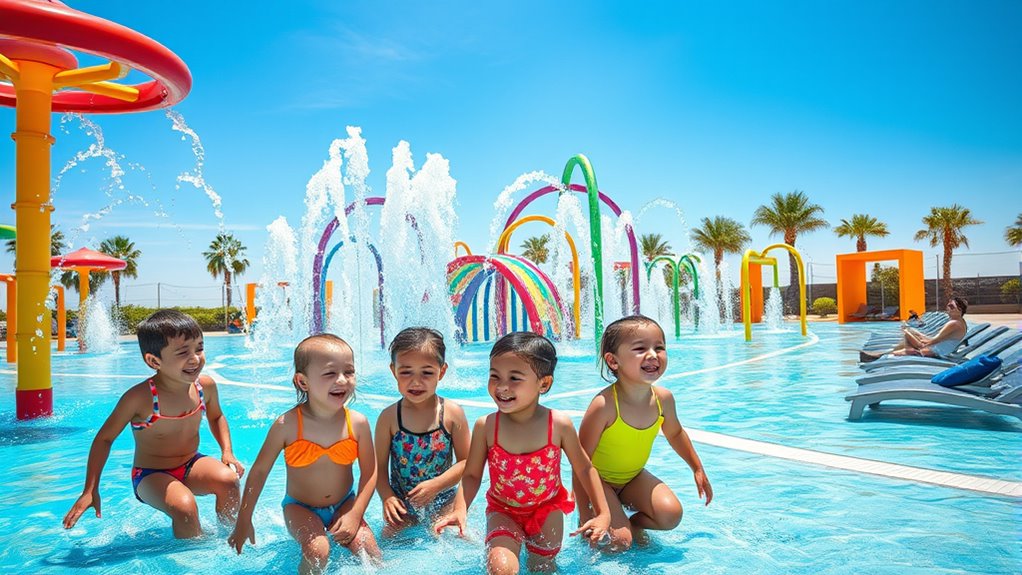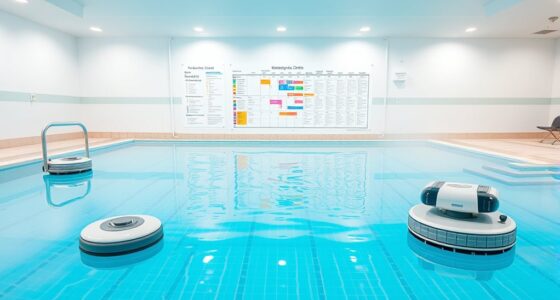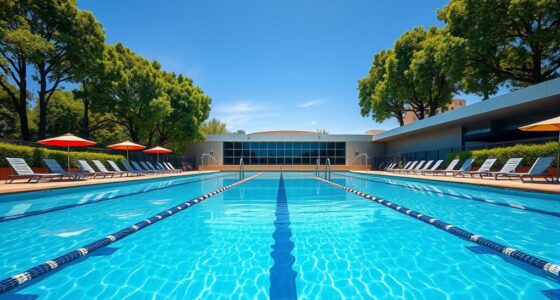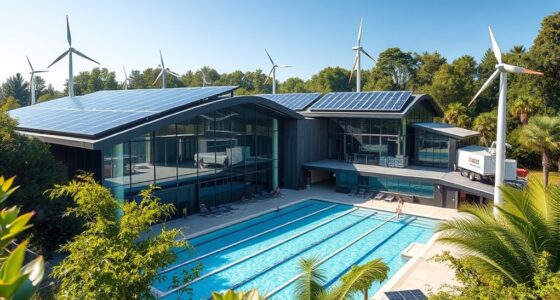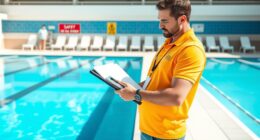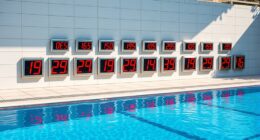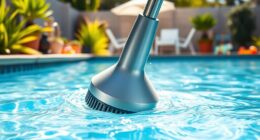Integrating splash pads and water playgrounds into public pools allows you to create safer, more inclusive, and engaging environments for everyone. These features add fun and excitement while emphasizing water safety and accessibility, making the space welcoming for children and adults with different needs. By incorporating safety measures like non-slip surfaces and accessible design, you’ll foster confidence and encourage active participation. Stay with us to explore how you can transform your pool into a vibrant community hub.
Key Takeaways
- Incorporate safety features such as non-slip surfaces and gentle water flows for secure, inclusive play environments.
- Design accessible features like ramps, transfer stations, and adjustable water jets to accommodate diverse user needs.
- Use colorful, themed structures and interactive elements to enhance engagement and promote active, imaginative play.
- Ensure safety and supervision through soft ground surfaces and controlled water pressures in splash zones.
- Foster community involvement by creating vibrant, inclusive water play areas that encourage social interaction and water safety skills.
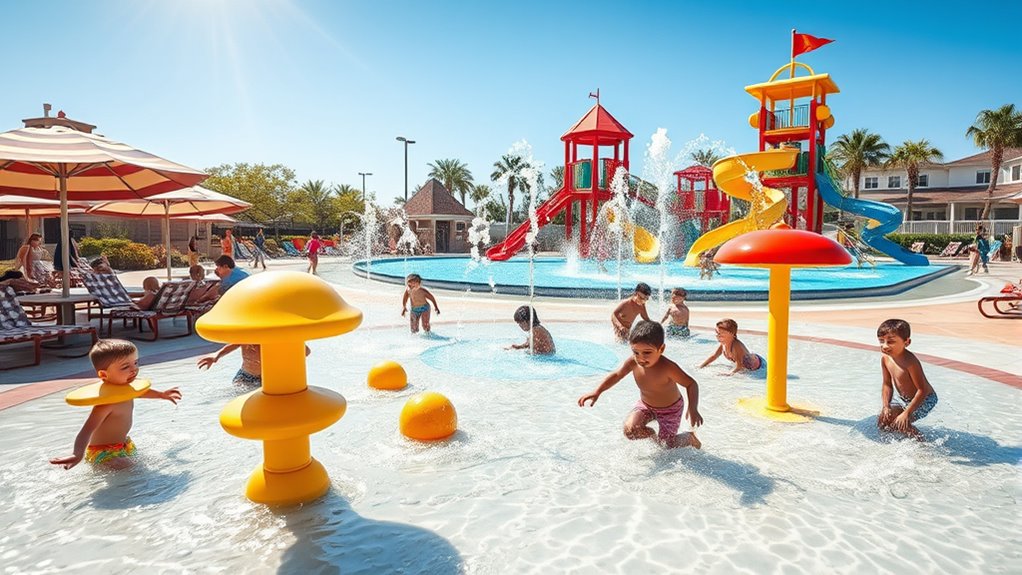
Have you ever wondered why splash pads and water playgrounds are becoming popular features in public pools? The answer lies in their ability to make swimming areas more engaging and inclusive for everyone. These features not only add fun but also emphasize the importance of water safety and accessibility. When designed thoughtfully, splash pads and water playgrounds can serve as safe zones where children and adults alike can enjoy water activities without the risks associated with deeper pools. You’ll find that many modern installations incorporate safety measures like non-slip surfaces, gentle water flows, and controlled spray zones to minimize accidents. These features help create a secure environment where parents and guardians feel comfortable allowing their kids to explore water play freely.
Splash pads boost safety and fun, making water activities accessible and engaging for everyone.
Accessibility features are a vital element in integrating splash pads and water playgrounds into public pools. You want to guarantee that everyone, regardless of physical ability, can enjoy the water. This means including ramps, wide entry points, and transfer stations that make it easy for individuals with mobility challenges to access the water play areas. Some pools go further by incorporating adjustable water jets and interactive features that can be operated by people with different needs. By prioritizing accessibility, you foster an inclusive atmosphere where children of all abilities can participate equally, promoting social interaction and physical activity. This inclusivity not only benefits individuals but also enhances the overall community appeal of the public pool.
In addition to safety and accessibility, splash pads and water playgrounds often feature innovative designs that encourage active play. You might notice colorful structures, themed elements, or interactive water features that stimulate imagination and physical engagement. These designs motivate children to move around, develop coordination, and build confidence in the water. When you combine these playful elements with safety features like soft ground surfaces and carefully monitored water pressures, you create an environment that’s both fun and secure. Such thoughtful integration ensures that water play becomes a positive experience, helping children learn water safety skills naturally as they enjoy themselves.
Implementing somatic therapy techniques like body awareness and mindful movement can also enhance the experience of water play by helping children and adults connect more deeply with their physical sensations and promote relaxation around water environments. When you integrate somatic awareness into water activities, participants may experience improved emotional regulation and confidence in water safety skills. Ultimately, incorporating splash pads and water playgrounds into public pools isn’t just about adding visual appeal; it’s about fostering a safe, inclusive, and engaging environment for everyone. By focusing on water safety and accessibility features, you guarantee that your pool becomes a welcoming space where families can gather, children can explore, and everyone can enjoy the benefits of water play responsibly. These features help break down barriers, making water activities accessible and enjoyable for all ages and abilities, transforming ordinary pools into vibrant community hubs.
Frequently Asked Questions
What Safety Standards Are Required for Splash Pads?
You need to follow strict safety standards for splash pads, including maintaining water quality to prevent bacteria growth and guarantee clear, safe water. Lifeguard requirements are vital; trained staff must constantly monitor the area, enforce rules, and respond quickly to emergencies. Regular inspections and maintenance are also essential to keep equipment safe and functioning correctly. Adhering to these standards helps provide a fun, safe environment for all water park visitors.
How Much Maintenance Do Water Playgrounds Need?
Think of your water playground as a lively garden that needs daily tending. You’ll want to perform regular maintenance routines like inspecting equipment, cleaning surfaces, and checking water quality management systems. This guarantees safety and sanitation, preventing issues before they start. Typically, daily, weekly, and monthly checks keep everything running smoothly. Proper maintenance extends the lifespan of your water playground and keeps kids safe and happy, turning it into a splash zone of joy.
What Is the Cost Difference Between Traditional Pools and Splash Pads?
You’ll find that splash pads generally cost less than traditional pools when considering the initial investment. The cost comparison shows splash pads have lower installation expenses because they require simpler infrastructure and smaller footprints. Maintenance costs tend to be lower too, making splash pads a budget-friendly option for communities. Overall, choosing a splash pad can help you save money while still providing a fun, engaging water experience for visitors.
Are Splash Pads Accessible for Disabled Children?
Splash pads are incredibly accessible for disabled children, thanks to inclusive design and sensory accessibility features. You’ll find wide, smooth pathways, lowered water elements, and tactile cues that cater to various needs. This creates an environment where every child can joyfully participate, regardless of mobility or sensory challenges. By prioritizing these features, you guarantee that your water playground truly welcomes all children, fostering equality and unforgettable fun for everyone involved.
How Do Water Play Areas Impact Pool Insurance Policies?
Water play areas can increase your liability insurance costs because they add potential risks for accidents and injuries. You’ll need to review your coverage policies carefully, as some insurers may require additional coverage or safety measures to protect against claims. Staying proactive by implementing safety protocols and proper signage can help manage liability and keep your insurance premiums reasonable, ensuring a safer experience for everyone.
Conclusion
By incorporating splash pads and water playgrounds into public pools, you create a fun, safe, and versatile environment. You provide excitement, promote social interaction, and encourage active play. You enhance the community experience, support family enjoyment, and foster lasting memories. You transform ordinary pools into vibrant hubs of activity. Embrace the opportunity to innovate, to inspire, and to delight. Together, you can make your pool a splash of joy and a playground of endless fun.
